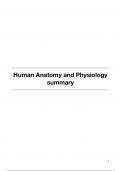Human Anatomy and Physiology
summary
1
,Introduction to Anatomy 3
The Heart 4
Anatomy of the Heart 4
Embryology — Development of the Heart 8
Physiology of the Heart 10
The Blood circulation 17
Anatomy of the Blood circulation 17
Physiology of the Blood circulation 21
The Respiratory system 28
Anatomy of the Respiratory system 28
Physiology of the Respiratory system 34
The Kidneys / Urinary system 40
Physiology of the Kidneys 40
Anatomy of the Urinary system 46
Exercise physiology 49
Regulation of metabolism 49
Aerobic exercise capacity 50
Cardiovascular and respiratory adaptations 52
2
, Introduction to Anatomy
- History:
- Greeks did some anatomy, but for a long time, anatomy was not performed: taboo to cut
in other peoples’ bodies
- Doctors vs surgeons:
- Doctors studied from books and never looked at human body; performed blood
letting to restore imbalance of 4 humors (bodily uids)
- No anatomical images available to them
- Surgeons were not educated (e.g. barbers/butchers); cut the bodies
- 1543: Vesalius made rst anatomical atlas (De humani corporis fabrica)
- Renaissance: starting to open bodies to explore, instead of just relying on book
- See what you believe vs believing what you see
- Anatomy vs physiology:
- Anatomy = studying structure of the body
- Macroscopic to microscopic
- Clinical anatomy + anatomical embryology
- Physiology = studying bodily functions
- Biochemistry + biology + chemistry + genetics
- Structure <-> function
- Organizational levels: atoms -> protein -> laments -> cells -> muscle tissue -> organ ->
organ system -> organism
- Anatomy looks at organ + organ system + organism
- Organ systems:
- Integumentary (=everything that encapsulates us):
- Organs: skin, hair, sweat glands, nails
- Functions: protection against environmental hazards, regulation of body temperature,
providing sensory information
- Skeletal:
- Organs: bones, cartilage, ligaments, bone marrow
- Functions: support+protection for other tissues, storage of calcium and other
minerals, formation of blood cells
- Muscular:
- Organs: skeletal muscles
- Functions: generation of heat+movement+protection, support other tissues
- Nervous:
- Organs: brain, spinal cord, peripheral nerves, sense organs
- Functions: direct immediate responses to stimuli, coordination/moderation of
activities of other organ systems, providing+interpreting sensory information about
external conditions
- Endocrine (=all organs that produce hormones):
- Organs: pituitary+thyroid+adrenal glands, pancreas, gonads, endocrine tissues in
other systems
- Functions: direct long-term changes in activities of other organ systems, adjustment
of metabolic activity and energy use by body, control of many structural+functional
changes during development
- Lymphatic:
- Organs: spleen, thymus, lymphatic vessels/nodes, tonsils
- Functions: defense against infection+disease, return tissue uids to blood stream
- Digestive:
- Organs: teeth, tongue, pharynx, esophagus, stomach, small+large intestine, liver,
gallbladder, pancreas
- Functions: process+digest food, absorb+conserve water, absorb nutrients, store
energy reserves
3
fi fi fl fl
, - Reproductive:
- Male:
- Organs: testes, epididymis, ductus deferentia, seminal vesicles, prostate, penis,
scrotum
- Functions: sexual intercourse, and production of male sex cells (sperm), seminal
uids and hormones
- Female:
- Organs: ovaries, uterine tubes, uterus, vagina, labia, clitoris, mammillary glands
- Functions: sexual intercourse, provide milk to nourish newborn infant, support
developing embryo from conception to delivery, production of female sex cells
(oocytes) and hormones
- Cardiovascular:
- Organs: heart, blood, blood vessels
- Functions: distribution of heat and assistance in body temperature control, and
distribution of blood cells, water, and dissolved materials (incl. nutrients, waste
products, O2, CO2)
- Respiratory:
- Organs: nasal cavities, sinuses, larynx, trachea, bronchi, lungs, alveoli
- Functions: deliver air to alveoli (=sites in lungs where gas exchange occurs), provide
O2 to bloodstream, remove CO2 from bloodstream, produce sounds for
communication
- Urinary:
- Organs: kidney, ureters, bladder, urethra
- Functions: excretion of waste products from blood, control water balance by
regulation of urine volume produced, storage of urine prior to voluntary elimination,
regulation of blood ion concentrations and pH
- Topography of human body is all described relative to anatomical stance
- Anatomical planes:
- Coronal = vertical plane dividing body into front and back section
- Sagittal = vertical plane dividing body into left and right section
- Transverse = horizontal plane dividing body into upper and lower section
- Anterior (=front=ventral) vs posterior (=back=dorsal)
- Superior (=top=cranial) vs inferior (=bottom=caudal)
- Proximal (=nearby) vs distal (=further)
- Medial (=midline) vs lateral (=further from midline)
The Heart
ANATOMY OF THE HEART
- The heart:
- Never rests; beats ~100,000x a day (70x/min)
- Pumps 8,000 L/day
- Is as big as your st
- Anatomical position of the heart:
- Located in the middle of the thorax, but bit turned to the left
- Base of the heart (incl. main vessels) — behind sternal angle (=little bump where 2nd rib
joins with sternum), centered a bit to the left
- Lower right point of the heart — 5th intercostal space parasternal on the right (=5th
space between the ribs, next to sternum on the right)
- Apex of the heart (inferior pointed tip) — 5th intercostal space midclavicular on the left
(=5th space between the ribs, at middle of clavicle on the left)
- The great vessels (arteries+veins) are connected to the superior end of the heart at its base
4
fl
fi






